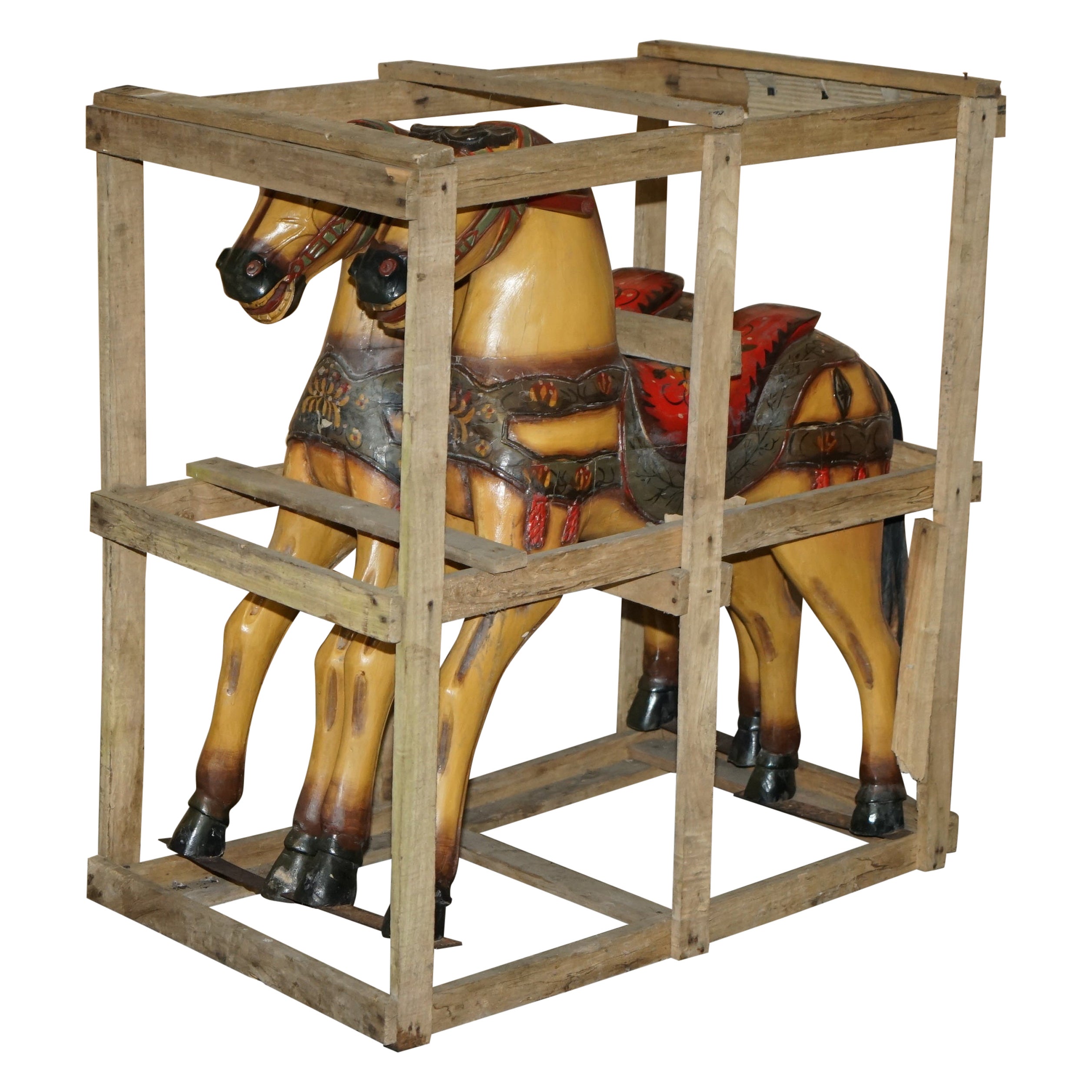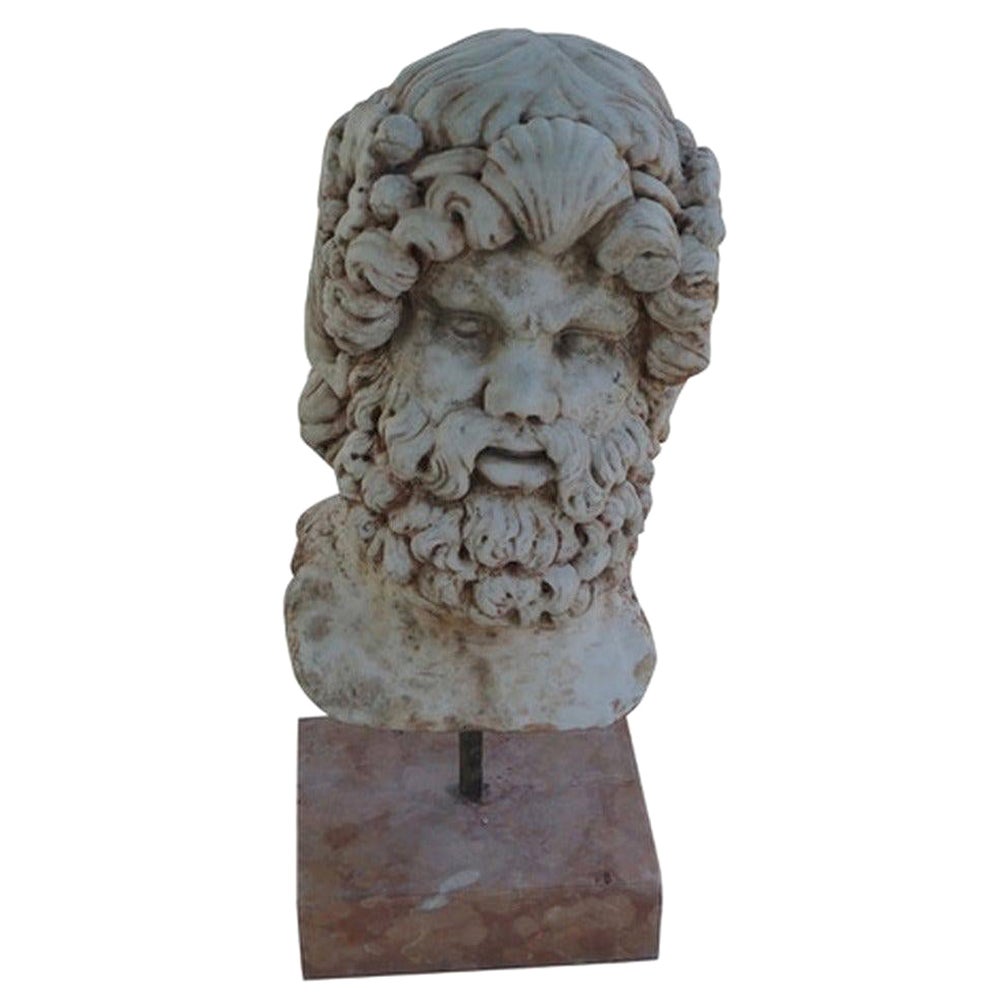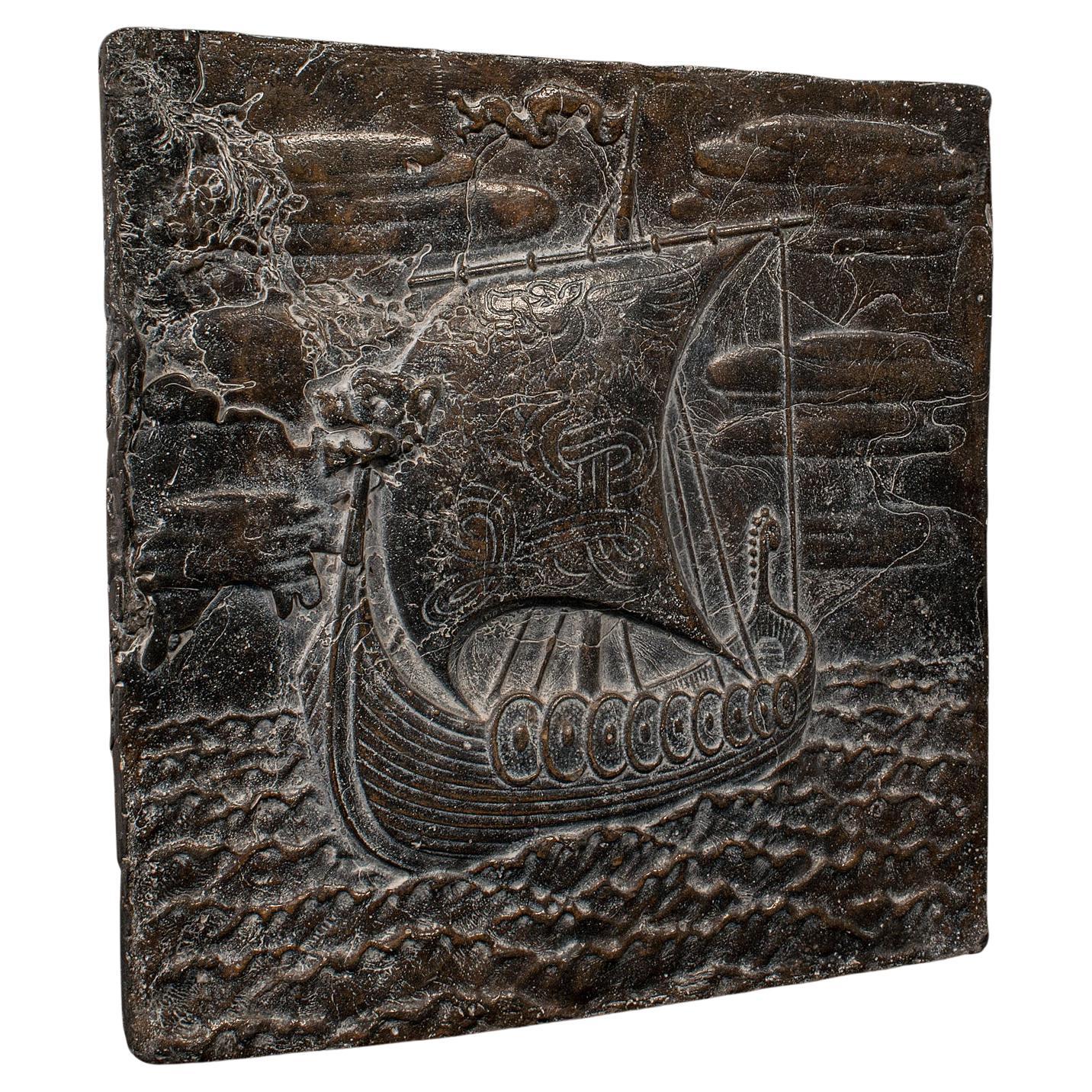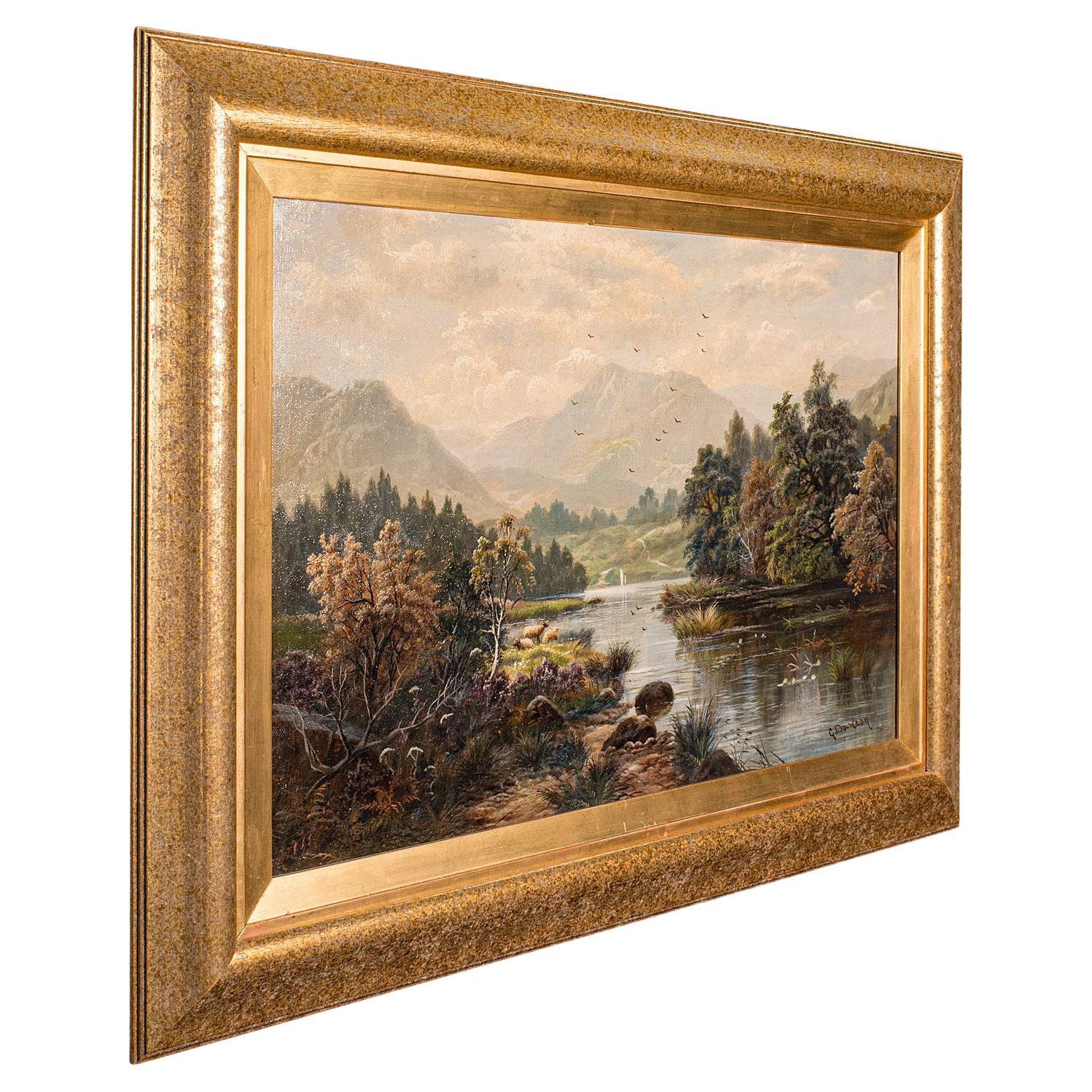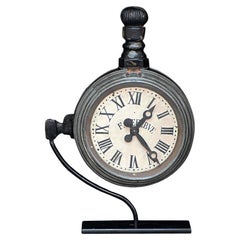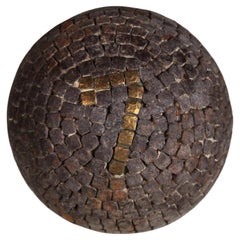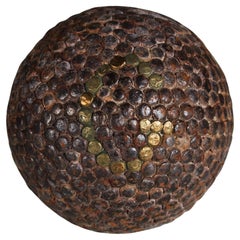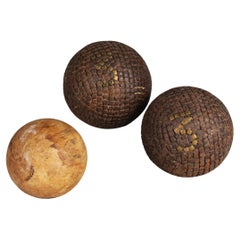Late Victorian Folk Art
1
50
to
2
40
9
50
50
50
2,058
1,118
1,112
317
193
184
110
107
83
59
42
38
28
21
21
18
6
39
11
10
1
2
2
4
37
19
18
18
4
40
26
8
5
3
1
1
1
Style: Late Victorian
PAIR OF CIRCA 1890 ORiGINAL PAINT NEW OLD STOCK CRATED FAIRGROUND RIDE HORSES
Located in GB
Royal House Antiques
Royal House Antiques is delighted to offer for sale this absolutely exquisite pair of new old stock Fairground ride horses
Please note the delivery fee listed ...
Category
1890s Antique Late Victorian Folk Art
Materials
Wood
Early 20th Century Double Sided Clock Makers Trade Sign
Located in London, GB
Early 20th Century Double Sided Clock Makers Trade Sign
A working example of an early 20th Century double sided clock makers trade sign clock. This item would have originally hung ...
Category
1920s French Vintage Late Victorian Folk Art
Materials
Zinc
Antique Boule Ball "7", Pétanque, 1880s, France, Craftsmanship
Located in Greven, DE
Beautiful, unique Boule ball, France, late 19th Century.
In the 19th century, the manufacture of boules balls underwent significant development in France as the game of boules, particularly the pétanque variant, gained in popularity. The manufacture of boules balls during this period was a manual process that required expertise, precision and love to detail.
In the late 19th and early 20th centuries, particularly in rural areas of France and other Mediterranean regions, olive wood was a commonly used source of material for making boules balls. This was not only due to the availability of the material, but also to the outstanding properties of olive wood, which was characterized by hardness, strength and a rich grain.
First, the olive wood was carefully selected and shaped into raw balls, which were then sanded to the desired size and shape. The nails were then hammered into the balls one by one, making sure that they were evenly distributed and firmly anchored. Finally, the spheres were polished and coated with a protective varnish to enhance their natural beauty and protect them from the elements.
The use of nails to decorate and reinforce olive wood boules was a traditional practice that not only gave the ball a rustic aesthetic, but also improved its durability and contributed to customization. Many balls were made according to the specific requirements and preferences of the players. Nails were driven at regular intervals around the ball, with each nail hole precisely placed so as not to affect the balance and weight distribution of the ball. These nails not only served as a decorative element, but also helped to strengthen the structure of the ball and make it more resistant to the hard knocks and wear and tear during play. Individual engravings or decorations were often applied to the balls to make them unique and identify the player.
Antique boules...
Category
Late 19th Century French Antique Late Victorian Folk Art
Materials
Metal
Antique Boule Ball "G", Pétanque, 1880s, France, Craftsmanship
Located in Greven, DE
Beautiful, unique Boule ball, France, late 19th Century.
In the 19th century, the manufacture of boules balls underwent significant development in France as the game of boules, particularly the pétanque variant, gained in popularity. The manufacture of boules balls during this period was a manual process that required expertise, precision and love to detail.
In the late 19th and early 20th centuries, particularly in rural areas of France and other Mediterranean regions, olive wood was a commonly used source of material for making boules balls. This was not only due to the availability of the material, but also to the outstanding properties of olive wood, which was characterized by hardness, strength and a rich grain.
First, the olive wood was carefully selected and shaped into raw balls, which were then sanded to the desired size and shape. The nails were then hammered into the balls one by one, making sure that they were evenly distributed and firmly anchored. Finally, the spheres were polished and coated with a protective varnish to enhance their natural beauty and protect them from the elements.
The use of nails to decorate and reinforce olive wood boules was a traditional practice that not only gave the ball a rustic aesthetic, but also improved its durability and contributed to customization. Many balls were made according to the specific requirements and preferences of the players. Nails were driven at regular intervals around the ball, with each nail hole precisely placed so as not to affect the balance and weight distribution of the ball. These nails not only served as a decorative element, but also helped to strengthen the structure of the ball and make it more resistant to the hard knocks and wear and tear during play. Individual engravings or decorations were often applied to the balls to make them unique and identify the player.
Antique boules...
Category
Late 19th Century French Antique Late Victorian Folk Art
Materials
Metal
Antique Boule Ball "G", Pétanque, 1880s, France, Craftsmanship
Located in Greven, DE
Beautiful, unique Boule ball, France, late 19th Century.
In the 19th century, the manufacture of boules balls underwent significant development in France as the game of boules, particularly the pétanque variant, gained in popularity. The manufacture of boules balls during this period was a manual process that required expertise, precision and love to detail.
In the late 19th and early 20th centuries, particularly in rural areas of France and other Mediterranean regions, olive wood was a commonly used source of material for making boules balls. This was not only due to the availability of the material, but also to the outstanding properties of olive wood, which was characterized by hardness, strength and a rich grain.
First, the olive wood was carefully selected and shaped into raw balls, which were then sanded to the desired size and shape. The nails were then hammered into the balls one by one, making sure that they were evenly distributed and firmly anchored. Finally, the spheres were polished and coated with a protective varnish to enhance their natural beauty and protect them from the elements.
The use of nails to decorate and reinforce olive wood boules was a traditional practice that not only gave the ball a rustic aesthetic, but also improved its durability and contributed to customization. Many balls were made according to the specific requirements and preferences of the players. Nails were driven at regular intervals around the ball, with each nail hole precisely placed so as not to affect the balance and weight distribution of the ball. These nails not only served as a decorative element, but also helped to strengthen the structure of the ball and make it more resistant to the hard knocks and wear and tear during play. Individual engravings or decorations were often applied to the balls to make them unique and identify the player.
Antique boules...
Category
Late 19th Century French Antique Late Victorian Folk Art
Materials
Metal
Pair Of Antique Boule Balls "3", Pétanque, 1880s, France, Craftsmanship
Located in Greven, DE
Beautiful, unique Boule ball pair and one target ball, France, late 19th Century.
Decorated with the numer "3" on each of the Boule balls.
In the 19th century, the manufacture of b...
Category
Late 19th Century French Antique Late Victorian Folk Art
Materials
Olive
Antique Boule Set, Boule Balls, Pétanque, 1880s, France, Craftsmanship
Located in Greven, DE
Beautiful, unique Boule set of two Boule balls and one target ball, France, late 19th century.
In the 19th century, the manufacture of boule balls underwent significant development ...
Category
Late 19th Century French Antique Late Victorian Folk Art
Materials
Olive
Pair Of Antique Boule Balls, Pétanque, 1880s, France, Craftsmanship
Located in Greven, DE
Beautiful, unique Boule ball pair, France, late 19th Century.
Diameter 9,5 cm.
In the 19th century, the manufacture of boules balls underwent significant development in France as the game of boules, particularly the pétanque variant, gained in popularity. The manufacture of boules balls during this period was a manual process that required expertise, precision and love to detail.
In the late 19th and early 20th centuries, particularly in rural areas of France and other Mediterranean regions, olive wood was a commonly used source of material for making boules balls. This was not only due to the availability of the material, but also to the outstanding properties of olive wood, which was characterized by hardness, strength and a rich grain.
First, the olive wood was carefully selected and shaped into raw balls, which were then sanded to the desired size and shape. The nails were then hammered into the balls one by one, making sure that they were evenly distributed and firmly anchored. Finally, the spheres were polished and coated with a protective varnish to enhance their natural beauty and protect them from the elements.
The use of nails to decorate and reinforce olive wood boules was a traditional practice that not only gave the ball a rustic aesthetic, but also improved its durability and contributed to customization. Many balls were made according to the specific requirements and preferences of the players. Nails were driven at regular intervals around the ball, with each nail hole precisely placed so as not to affect the balance and weight distribution of the ball. These nails not only served as a decorative element, but also helped to strengthen the structure of the ball and make it more resistant to the hard knocks and wear and tear during play. Individual engravings or decorations were often applied to the balls to make them unique and identify the player.
Antique boules...
Category
Late 19th Century French Antique Late Victorian Folk Art
Materials
Olive
Pair Of Antique Boule Balls "24", Pétanque, 1880s, France, Craftsmanship
Located in Greven, DE
Beautiful, unique Boule ball pair and one target ball, France, late 19th Century.
In the 19th century, the manufacture of boules balls underwent significant development in France as...
Category
Late 19th Century French Antique Late Victorian Folk Art
Materials
Olive
Pair Of Antique Boule Balls "4", Pétanque, 1880s, France, Craftsmanship
Located in Greven, DE
Beautiful, unique Boule ball pair, France, late 19th Century.
Diameter 9,4 cm.
In the 19th century, the manufacture of boules balls underwent significant development in France as th...
Category
Late 19th Century French Antique Late Victorian Folk Art
Materials
Olive
Antique Boule Balls Set "B", Pétanque, 1880s, France, Craftsmanship
Located in Greven, DE
Beautiful, unique Boule set of three Boule balls and one target ball, France, late 19th century.
In the 19th century, the manufacture of boules balls underwent significant development in France as the game of boules, particularly the pétanque variant, gained in popularity. The manufacture of boules balls during this period was a manual process that required expertise, precision and love to detail.
In the late 19th and early 20th centuries, particularly in rural areas of France and other Mediterranean regions, olive wood was a commonly used source of material for making boules balls. This was not only due to the availability of the material, but also to the outstanding properties of olive wood, which was characterized by hardness, strength and a rich grain.
First, the olive wood was carefully selected and shaped into raw balls, which were then sanded to the desired size and shape. The nails were then hammered into the balls one by one, making sure that they were evenly distributed and firmly anchored. Finally, the spheres were polished and coated with a protective varnish to enhance their natural beauty and protect them from the elements.
The use of nails to decorate and reinforce olive wood boules was a traditional practice that not only gave the ball a rustic aesthetic, but also improved its durability and contributed to customization. Many balls were made according to the specific requirements and preferences of the players. Nails were driven at regular intervals around the ball, with each nail hole precisely placed so as not to affect the balance and weight distribution of the ball. These nails not only served as a decorative element, but also helped to strengthen the structure of the ball and make it more resistant to the hard knocks and wear and tear during play. Individual engravings or decorations were often applied to the balls to make them unique and identify the player.
Antique boules...
Category
Late 19th Century French Antique Late Victorian Folk Art
Materials
Olive
Antique Boule Set, Boule Balls, Pétanque, 1880s, France, Craftsmanship
Located in Greven, DE
Beautiful, unique Boule set of three Boule balls and one target ball, France, late 19th Century.
Diameter 8,5 cm.
Fantastic colour and patina!
In the 19th century, antique metal boules balls experienced a renaissance that took the game of boules to a new level.
These ornately crafted balls were not only instruments of the game, but also symbols of elegance and sophistication in leisure activities.
Made from high-quality metals such as steel or brass, Boule balls were forged and polished by skilled craftsmen to ensure a smooth and even surface.
The antique boules...
Category
Late 19th Century French Antique Late Victorian Folk Art
Materials
Metal
Antique Boule Ball "G", "J", Pétanque, 1880s, France, Craftsmanship
Located in Greven, DE
Beautiful, unique Boule ball, France, late 19th Century.
Decorated with the initials "G" and "J".
In the 19th century, the manufacture of boules balls underwent significant developm...
Category
Late 19th Century French Antique Late Victorian Folk Art
Materials
Olive
Pair Of Antique Boule Balls "G", Pétanque, 1880s, France, Craftsmanship
Located in Greven, DE
Beautiful, unique Boule ball pair, France, late 19th Century.
In the 19th century, the manufacture of boules balls underwent significant development in France as the game of boules,...
Category
Late 19th Century French Antique Late Victorian Folk Art
Materials
Olive
Pair Of Antique Boule Balls "3", "V", Pétanque, 1880s, France, Craftsmanship
Located in Greven, DE
Beautiful, unique Boule ball pair, France, late 19th Century.
Decorated with the numer "3" on each ball and with a "V" on one of the Boule balls.
In the 19th century, the manufactur...
Category
Late 19th Century French Antique Late Victorian Folk Art
Materials
Olive
Pair Of Antique Boule Balls, Pétanque, 1880s, France, Craftsmanship
Located in Greven, DE
Beautiful, unique Boule ball pair and one target ball, France, late 19th Century.
In the 19th century, the manufacture of boules balls underwent significant development in France as...
Category
Late 19th Century French Antique Late Victorian Folk Art
Materials
Metal
Antique Boule Balls Set "9", Pétanque, 1880s, France, Craftsmanship
Located in Greven, DE
Beautiful, unique Boule set of three Boule balls and one target ball, France, late 19th century.
In the 19th century, the manufacture of boules balls underwent significant development in France as the game of boules, particularly the pétanque variant, gained in popularity. The manufacture of boules balls during this period was a manual process that required expertise, precision and love to detail.
In the late 19th and early 20th centuries, particularly in rural areas of France and other Mediterranean regions, olive wood was a commonly used source of material for making boules balls. This was not only due to the availability of the material, but also to the outstanding properties of olive wood, which was characterized by hardness, strength and a rich grain.
First, the olive wood was carefully selected and shaped into raw balls, which were then sanded to the desired size and shape. The nails were then hammered into the balls one by one, making sure that they were evenly distributed and firmly anchored. Finally, the spheres were polished and coated with a protective varnish to enhance their natural beauty and protect them from the elements.
The use of nails to decorate and reinforce olive wood boules was a traditional practice that not only gave the ball a rustic aesthetic, but also improved its durability and contributed to customization. Many balls were made according to the specific requirements and preferences of the players. Nails were driven at regular intervals around the ball, with each nail hole precisely placed so as not to affect the balance and weight distribution of the ball. These nails not only served as a decorative element, but also helped to strengthen the structure of the ball and make it more resistant to the hard knocks and wear and tear during play. Individual engravings or decorations were often applied to the balls to make them unique and identify the player.
Antique boules...
Category
Late 19th Century French Antique Late Victorian Folk Art
Materials
Olive
Pair Of Antique Boule Balls Circle, Pétanque, 1880s, France, Craftsmanship
Located in Greven, DE
Beautiful, unique Boule ball pair and one target ball, France, late 19th Century.
In the 19th century, the manufacture of boules balls underwent significant development in France as...
Category
Late 19th Century French Antique Late Victorian Folk Art
Materials
Olive
Antique Boule Balls Set "B", Pétanque, 1880s, France, Craftsmanship
Located in Greven, DE
Beautiful, unique Boule set of three Boule balls, France, late 19th Century.
In the 19th century, the manufacture of boules balls underwent significant development in France as the game of boules, particularly the pétanque variant, gained in popularity. The manufacture of boules balls during this period was a manual process that required expertise, precision and love to detail.
In the late 19th and early 20th centuries, particularly in rural areas of France and other Mediterranean regions, olive wood was a commonly used source of material for making boules balls. This was not only due to the availability of the material, but also to the outstanding properties of olive wood, which was characterized by hardness, strength and a rich grain.
First, the olive wood was carefully selected and shaped into raw balls, which were then sanded to the desired size and shape. The nails were then hammered into the balls one by one, making sure that they were evenly distributed and firmly anchored. Finally, the spheres were polished and coated with a protective varnish to enhance their natural beauty and protect them from the elements.
The use of nails to decorate and reinforce olive wood boules was a traditional practice that not only gave the ball a rustic aesthetic, but also improved its durability and contributed to customization. Many balls were made according to the specific requirements and preferences of the players. Nails were driven at regular intervals around the ball, with each nail hole precisely placed so as not to affect the balance and weight distribution of the ball. These nails not only served as a decorative element, but also helped to strengthen the structure of the ball and make it more resistant to the hard knocks and wear and tear during play. Individual engravings or decorations were often applied to the balls to make them unique and identify the player.
Antique boules...
Category
Late 19th Century French Antique Late Victorian Folk Art
Materials
Olive
Antique Boule Set, Boule Balls, Pétanque, 1880s, France, Craftsmanship
Located in Greven, DE
Beautiful, unique Boule set of three Boule balls, France, late 19th century.
In the 19th century, antique metal boules balls experienced a renaissance that took the game of boules to a new level.
These ornately crafted balls were not only instruments of the game, but also symbols of elegance and sophistication in leisure activities.
Made from high-quality metals such as steel or brass, Boule balls were forged and polished by skilled craftsmen to ensure a smooth and even surface.
The antique boules...
Category
Late 19th Century French Antique Late Victorian Folk Art
Materials
Metal
Antique Boule Set, Boule Balls, Pétanque, 1880s, France, Craftsmanship
Located in Greven, DE
Beautiful, unique Boule set of three Boule balls and one target ball, France, late 19th century.
In the 19th century, the manufacture of boule balls underwent significant developmen...
Category
Late 19th Century French Antique Late Victorian Folk Art
Materials
Olive
Antique Boule Set, Boule Balls, Pétanque, 1880s, France, Craftsmanship
Located in Greven, DE
Beautiful, unique Boule set of three Boule balls and one target ball, France, late 19th Century.
Fantastic colour and patina!
In the 19th century, antique metal boules balls experienced a renaissance that took the game of boules to a new level.
These ornately crafted balls were not only instruments of the game, but also symbols of elegance and sophistication in leisure activities.
Made from high-quality metals such as steel or brass, Boule balls were forged and polished by skilled craftsmen to ensure a smooth and even surface.
The antique boules...
Category
Late 19th Century French Antique Late Victorian Folk Art
Materials
Metal
Antique Boule Set, Boule Balls, Pétanque, 1880s, France, Craftsmanship
Located in Greven, DE
Beautiful, unique Boule set of three Boule balls and one target ball, France, late 19th century.
In the 19th century, the manufacture of boules balls underwent significant developme...
Category
Late 19th Century French Antique Late Victorian Folk Art
Materials
Olive
Early 20th century carved wooden devil puppet
Located in London, GB
Early 20th century carved wooden devil puppet
A nice untouched example of an early 20th century hand carved wooden puppet in the form of a devil. Likely from a larger Punch and Judy...
Category
1920s Unknown Vintage Late Victorian Folk Art
Materials
Pine
Early 20th Century Double Sided Toleware French Dentists Trade Sign
Located in London, GB
Early 20th Century Double Sided Toleware French Dentists Trade Sign
An original untouched example of an early 20th Century toleware double sided Frenc...
Category
1910s French Vintage Late Victorian Folk Art
Materials
Sheet Metal
Classical Walking Stick in Ebonized Walnut & Sterling Pommel w/ Heraldic Crest
Located in New York, NY
This Classical Walking Stick in Ebonized Walnut & Sterling Pommel W/ Heraldic Crest originates from France during the Late 19th Century. Features a elegant and timeless profile with ...
Category
Late 19th Century French Antique Late Victorian Folk Art
Materials
Sterling Silver
19th C Folk Art J.Wheatley Jones Oil on Board Dog & Interior "Inferno" 1887
Located in Lowestoft, GB
A charming oil on board painting of a pondering dog in a country house kitchen. Age related craquelure to the painted surface, the odd knock and abrasion to the gilt gesso frame. But...
Category
Late 19th Century English Antique Late Victorian Folk Art
Materials
Canvas, Pine
Antique American Figural Painted Copper Horse Weatherwane with Cast Directional
Located in Hamilton, Ontario
This figural antique weathervane is usigned, but presumed to have originated from the United States and date to approximately 1880 and done in the...
Category
Late 19th Century American Antique Late Victorian Folk Art
Materials
Copper, Iron
Late 19th Century "9-Spot" Dominoe Game 55 Piece Set in Jointed Hardwood Box
Located in Lincoln, Lincolnshire
This is a rare and original '9 Spot' Dominoe game of 55 individual dominoes, coming complete with its jointed wooden box or case.
Dominoe sets are normally six-spot sets giving a to...
Category
Late 19th Century English Antique Late Victorian Folk Art
Materials
Bone, Wood
Set of Two Victorian Hand Carved & Hand Painted Black Forest Bear Figures
Located in High Wycombe, GB
Set of Two Victorian Hand Carved & Hand Painted Black Forest Bear Figures
Befit With Beaded Eyes
Largest bear dimensions Height 16cm I Width: 30cm I Depth: 12cm
Category
19th Century German Antique Late Victorian Folk Art
Materials
Wood
Large Antique Coffee Grinder, Germany circa 1900s
Located in Berghuelen, DE
A Large Antique Coffee Grinder, Germany circa 1900s
A large antique coffee grinder manufactured in Germany around 1900. Made with nutwood, iron crank and brass container for coffee ...
Category
Late 19th Century German Antique Late Victorian Folk Art
Materials
Brass
Victorian Style Cast Brass and Iron Fire Tools, 3 Pieces
Located in North Hollywood, CA
A set of Victorian style polished cast brass and wrought iron fire tools.
Elegant Victorian style ornate set of three brass fireplace tools with a iron stand.
The fire tool set is ...
Category
Mid-20th Century Unknown Late Victorian Folk Art
Materials
Brass
Late 19th Century Original Painted Green Faux Marble Dog Canine Kennel
Located in Lowestoft, GB
A charming painted wooden dog kennel with pitched roof standing on styled feet.
The original green painted body, with a faux marble painted pediment and red roof. The pediment als...
Category
Late 19th Century English Antique Late Victorian Folk Art
Materials
Pine
Painted Carved Wood Rocking Horse, 19th C.
Located in New York, NY
Child's carved rocking horse glider with paint decoration, likely circa late nineteenth century.
Dealer: S138XX
Category
Late 19th Century Antique Late Victorian Folk Art
Materials
Wood
Antique Decorative Lead Plaque, Scandinavian, Viking, Arts and Crafts, Victorian
Located in Hele, Devon, GB
This is a heavy antique decorative lead plaque. A Scandinavian, relief panel with Viking long ship scene, dating to the Arts & Crafts movement of the late ...
Category
Late 19th Century Scandinavian Antique Late Victorian Folk Art
Materials
Lead
Antique 1910s Armand Marseille Bisque Head Wiefel W & Co Character Doll
Located in Dayton, OH
"Antique early 20th century Wiefel & Company doll with bisque head by Armand Marseille, sleep eyes, composite hands, wood lengs, and soft body, marked “1908 DEP W & Co 121 AM” on back of head and dressed in a lace edged dress and floppy hat. “In 1912 Erste Steinbacher Porzellanfabrik was sold to Hugo Wiefel and renamed Wiefel & Company, thus a new doll mark was used of W & Co or W & C with or without a doll mold number.
By 1914 Wiefel's manufacturing was shut down because of World War I and restarted up again in 1918, although it doesn't appear that bisque doll...
Category
1910s Vintage Late Victorian Folk Art
Materials
Ceramic, Fabric, Hardwood
W. Hartmann Antique Oak & Copper Ships Binnacle Nautical Maritime Compass
By A. Lietz Co.
Located in Dayton, OH
Late 19th Century Ships Binnacle by W. Hartmann. Binnacles are an important navigation tool. They are often in the helm of the ship and allow sailor to maintain the correct course. This beautiful example has an octagonal case made from oak with brass fittings and removable copper dome...
Category
Late 19th Century Antique Late Victorian Folk Art
Materials
Brass, Copper
Antique Franz Bergman Vienna Cold Painted Bronze Cobra Snake Statue Watch Holder
Located in GB
We are delighted to offer for sale this stunning original Circa 1900 Austrian Vienna cold paint bronze Statue / Watch holder by the wonder that is Franz Bergman.
Fully stamped to ...
Category
Early 1900s Italian Antique Late Victorian Folk Art
Materials
Bronze
French Weathered Stone Statue of a Sleeping Putti, Baby Cherub with Wings
Located in Chillerton, Isle of Wight
French weathered stone statue of a sleeping putti, baby cherub with wings
Sleeping in the sunshine with his head on his arms and dainty wings on his back
This charming little pie...
Category
Early 1900s Antique Late Victorian Folk Art
Materials
Cast Stone
Early-20th Century English Folk Art Gentleman’s Swagger Stick
Located in London, GB
Early-20th Century English folk art gentleman’s swagger stick
An unusual early-20th century hand crafted English gentleman’s swagger stick. Made from...
Category
Early 20th Century British Late Victorian Folk Art
Materials
Wood
Late 19th Century Portrait Decorated Game Board
Located in Nantucket, MA
Late 19th century hand made and decoratively painted game board, circa 1890s to 1910, a checker or chess board with squares individually hand painted with miniature watercolor portra...
Category
Late 19th Century American Antique Late Victorian Folk Art
Materials
Wood
Early 20th Century Auntie Sally English Parlour Game
Located in London, GB
Early 20th century Auntie Sally English parlour game
A rare early 20th Century example of an English hand-crafted Aunt Sally parlour game. Made from pine wood this item has 22 wooden throwing sticks, 1 aunt sally figure, several clay pipes...
Category
1920s British Vintage Late Victorian Folk Art
Materials
Pine
Silk Embroidered Hand Painted Seascape by Thomas Willis, circa 1890
Located in Nantucket, MA
19th century silk embroidered and hand painted oil on canvas seascape by Thomas Willis (1850 - 1925), depicting a schooner-rigged racing yacht closely ha...
Category
1890s American Antique Late Victorian Folk Art
Materials
Canvas, Silk
19th Century Italian Socrates Mask, Carrara, Rosso Verona Marble Sculpture
Located in West Palm Beach, FL
An antique Italian mask of Socrates, the Classical Greek philosopher 470-399 BC. Hand carved in white Carrara marble and mounted on a Rosso Verona marble base, in good condition. Wea...
Category
Late 19th Century Italian Antique Late Victorian Folk Art
Materials
Marble, Carrara Marble
Lovely Late Victorian circa 1880 Hand Carved Black Forest Wine Bottle Holder
By Black Forest
Located in GB
We are delighted to offer for sale this absolutely lovely original circa 1880 Black forest carved wine bottle holder
A very good looking and decorative piece of folk art from the ...
Category
1880s German Antique Late Victorian Folk Art
Materials
Wood
Pair of 1894 Watercolour Paintings by H Brock Univited Guest, a Lion in the Path
Located in GB
We are delighted to offer for sale this lovely pair of late Victorian watercolors signed H Brock and dated Apr 1894
The first is titled “An Uninvited Guest” and the second “A Lion...
Category
1890s English Antique Late Victorian Folk Art
Materials
Wood
19th Century 24 Watercolor and Gouache Portraits of Gentry, Dancers, Artist
Located in Lowestoft, GB
A quite remarkable collection of twenty four watercolor and gouache full length portraits, the majority are dated (1872-1875) and signed with a monogram M.E. These images have come f...
Category
Late 19th Century English Antique Late Victorian Folk Art
Materials
Paper
Antique French Velocipede Horse Tricycle by Jean Louis Gourdoux for Jugnet
By Jean Louis Gourdoux
Located in Brooklyn, NY
Wonderfully detailed, antique, French, velocipede or toy tricycle featuring the body of a carved walnut horse with steel face plate on spoke wheels and ho...
Category
Late 19th Century French Antique Late Victorian Folk Art
Materials
Brass, Steel
Early 20th century set of four Fairground knock down figures.
Located in London, GB
Early 20th century set of four Fairground knock down figures.
The best examples of fairground are we have uncovered. An amazing set of 4 early 20th century hand crafted lead weighte...
Category
1920s French Vintage Late Victorian Folk Art
Materials
Metal
Early 20th Century English Butchers Shop Display Figure
Located in London, GB
Early 20th century English butchers shop display figure.
We share what we love, and we love this early 20th century papier Mache and wood composite figure. Recently acquired from a ...
Category
Early 20th Century British Late Victorian Folk Art
Materials
Wood, Paper
Late Victorian folk art for sale on 1stDibs.
Find a broad range of unique Late Victorian folk art for sale on 1stDibs. Many of these items were first offered in the Mid-20th Century, but contemporary artisans have continued to produce works inspired by this style. If you’re looking to add vintage folk art created in this style to your space, the works available on 1stDibs include folk art, more furniture and collectibles, decorative objects and other home furnishings, frequently crafted with wood, metal and other materials. If you’re shopping for used Late Victorian folk art made in a specific country, there are Europe, United Kingdom, and England pieces for sale on 1stDibs. While there are many designers and brands associated with original folk art, popular names associated with this style include A. Lietz Co., Black Forest, and Franz Bergmann. It’s true that these talented designers have at times inspired knockoffs, but our experienced specialists have partnered with only top vetted sellers to offer authentic pieces that come with a buyer protection guarantee. Prices for folk art differ depending upon multiple factors, including designer, materials, construction methods, condition and provenance. On 1stDibs, the price for these items starts at $291 and tops out at $8,740 while the average work can sell for $1,560.

